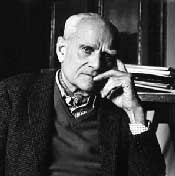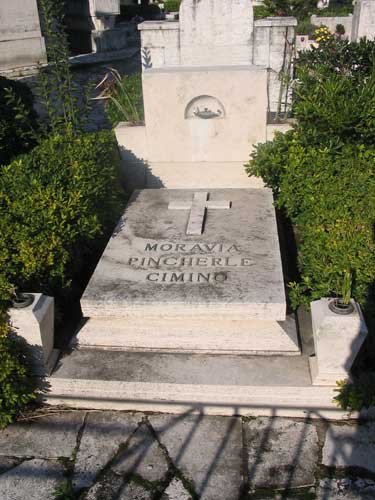
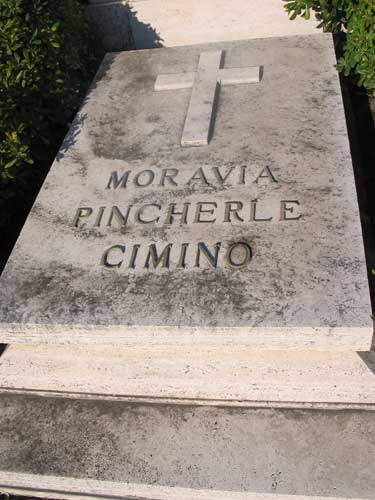
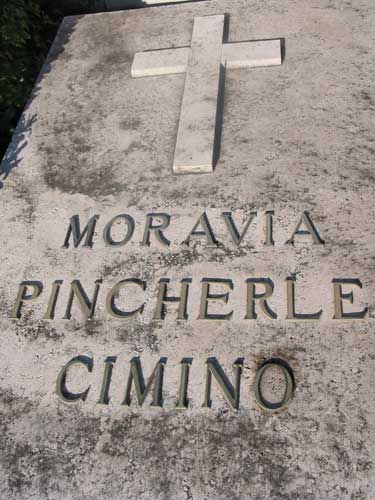
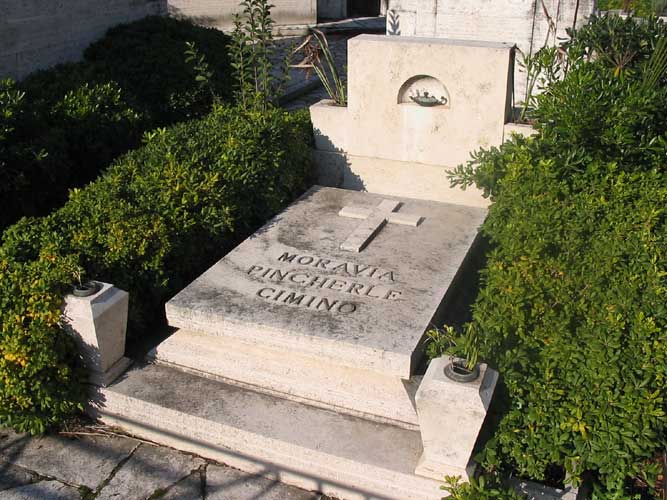
Italian journalist, short-story writer, and novelist. Moravia explored in
his books sex, social alienation, and other contemporary issues - he was a
major figure in the 20th-century Italian literature. Moravia was married to
Elsa Morante (1941-1963), who also was a writer, best known for her novel LA
STORIA (1974). Several of Moravia's books have been filmed, among them Two
Women by Vittorio De Sica (1960), A Ghost at Noon by Jean-Luc Godard (1964),
and The Conformist by Bernardo Bertolucci (1970).
"Alas, Fausta had told the truth: everything was left exactly as it had been
on the day I went away. One seemed to be poking one's nose into the study of
one of those long-dead writers whose rooms have been transformed into
museums, which are visited by people reverently and hat in hand. Except that
there was a difference: those writers whose rooms have been transformed into
museums were for the most part real, genuine writers; or were, in their
lifetime, sublimated artists of the first water, and their studies are
faithful mirrors of their sublimation. I, on the contrary, am desublimated,
and my study was clearly a museum of mediocrity, of approximation, of
self-didactism, of foolish aspirations, of the near miss, of amateurishness."
(from The Two of Us, 1971)
Alberto Pincherle (Alberto Moravia) was born in Rome into a well-to-do
middle-class Jewish-Catholic family. His mother was Teresa (de Marcanich)
Pincherle, and father, Carlo Pincherle, an architect and a painter. At the
age of nine Moravia was stricken with tubercular infection of the leg bones,
which he considered the most important factor in his early development. He
spent considerable periods from 1916 to 1925 in sanatoriums. During these
years Moravia started to write, and published at his own expense his first
major novel, GLI INDIFFERENTI (Time of Indifference) in 1929. It was perhaps
the first European Existentialist novel.
The story focuses on three days in the life of a Roman family, who keep up a
bourgeois front while living at the edge of poverty. The condemnation of the
Roman bourgeoisie under fascism became a sensation. Not to arouse the
disapproval of the authorities, Moravia wrote in an allegorical style, but
his increasing involvement in politics led to his books being banned.
Later Moravia in his other books used the typical characters of an impotent
intellectual, his virile rival, a voluptuous seductress, and an aging
mistress. Generally Moravia regarded women as being superior to men. He saw
sex as the enemy of love. Variations on the women of Gli indifferenti are
found in LA ROMANA (1947, The Woman of Rome), in which the protagonist,
Adriana, is a prostitute, and LA CIOCIARA (1958, Two Women). The loose,
rambling narrative recounts the war experiences of a calculating, widowed
businesswoman, Cesira, and her daughter, Rosetta, who flee into the
mountains to escape Fascist soldiers and Allied bombings. There they meet
Michele, the son of a shopkeeper, a committed idealist. She starts to feel
that if there had been a man who had attracted her "and who I could have
loved, love itself would have had a new savor, more profound and more
intense". Rosetta is raped by Moroccan soldiers - allies of the liberation
army. The American soldiers are "indifferent and distant", and "all of them
were chewing gum". Rosetta becomes a prostitute and her mother a thief, who
in her suicidal despair sees a vision of Michele telling her that life is
better than death. Moravia's criticism of society is presented on an
allegorical level - proletariat is raped by capitalism, Italy loses her
innocence under Fascism. The book was adapted for screen by Vittorio De Sica,
starring Sophia Loren, Jean-Paul Belmondo, and Eleonora Brown. In De Sica's
film, the relationship between Cesira and Rosetta is paralleled with the
image of Madonna and Child; Rosetta is the sacrificial victim. The rape
scene is set in a church, with the question where is God?
In the 1930s Moravia worked as a foreign correspondent for La Stampa and La
Gazetta del Popolo. He travelled in the U.S., Poland, China, Mexico, and
other countries. His works were censored by Benito Mussolini's fascist
government, and placed by the Vatican on the Index librorum prohibitarum
(Index of Forbidden Books). Moravia sharply criticized the dehumanized,
capitalist world. He was especially influenced by the thoughts of Marx and
Freud. After the publication of LE AMBIZIONI SBAGLIATE (1935, The Wheel of
Fortune), Moravia lost his job at the Gazetta del Popolo.
In 1937 Moravia's collection of short stories L'IMBROGLIO appeared, which
included L'Architetto, La Tempesta, and La Provinciale. Several of his
stories were first published in newspapers. RACCONTI ROMANI (1954, Roman
Tales) and NUOVI RACCONTI ROMANI (1959, More Roman Tales) include some of
Moravia's best sketches of working-class characters in everyday situations.
From 1941 to 1943 Moravia lived in Anacapri (Capri). In 1943 he tried to
escape to Naples, but unable to cross the frontier, fled with his wife Elsa
Morante into the mountains of Ciociaria. He had written in 1941 a comic
parody of the Mussolini government, LA MASCHERATA, attacked fascism in his
articles in Il Popolo di Roma, and was in danger of being arrested. He went
into hiding in the peasant community in Fondi, near Cassino, until the
Allied Liberation. In 1944 he started to write Two Women, but returned to
the work ten years later, when he had gained more distance from his own
experiences. However, the nine months among peasants strengthened his social
conscience and new sympathy for the people, which was evident in the short
novel AGOSTINO (1944). In IL CONFORMISTA (1951) Moravia portrays a person,
Marcello, who has dedicated himself to total conformity. He joins the
Fascist party, "as an abstract whole, as a great, existing army held
together by common feelings, common ideas, common aims, and army of which it
was comforting to form a part". Bernardo Bertolucci's film version was
according to the director a "story about me and Godard... I'm Marcello and I
make Fascist movies and I want to kill Godard who's revolutionary, and who
makes revolutionary movies and who was my teacher..." (Bertolucci in Sight
and Sound, Vol. 40, No. 2, Spring 1971) When Moravia stressed Marcello's
inevitable fate and followed a logical chronology, Bertolucci confused the
narrative progression of the text.
In the 1950s Moravia abandoned the third-person narrative, and used the
limited, non-objective first person narrative in tune with the modernist
literature theories. IL DISPREZZO (1954, A Ghost at Noon) was the basis of
Jean-Luc Godard's film Le Mépris (1963), starring Brigitte Bardot. The
director considered the novel "a nice, vulgar one for a train journey, full
of classical, old fashioned sentiments in spite of the modernity of the
situation. But it is with this kind of novel that one can often make the
best films." Godard played with the theme of the book - the adapting of
Homer's Odyssey to film - and developed further the triangle drama of
Odysseus, Penelope, and Poseidon. In the novel Riccardo Molteni, a not so
reliable narrator, tries to keep some sense of balance after the death of
his wife, Emilia. "How beautiful Emilia had been, sitting in the stern of my
boat, no longer hostile, but full of love, how sweet her words; how
disturbing, how violent the feeling I had experienced when I told her I
wanted to make love to her and she had answered me with that faint nod of
agreement!" In Le Mépris Bardot imitated the gestures of Godard's ex-wife
Anna Karina, and the director kept her half-dressed throughout the film, and
showed her swimming in the nude. The American actor Jack Palance played
Prokosch, a producer, and on another level Poseidon, Odysseus' archenemy.
Moravia'a attitude toward cinema was not admiring.
In 1953 with Alberto Carocci Moravia edited Nuovi Argomenti; he wrote film
reviews from 1955 for L'Espresso, and in 1955 he was a State Department
lecturer in the United States. Between the years 1958 and 1970 he travelled
throughout the world, and produced such travel books as The Red Book and the
Great Wall (1986) and Which Tribe Do You Belong To? (1974). In 1982 he
edited Nuovi Argomenti with Leonardo Sciascia and Enzo Siciliano. Among
Moravias later works are LA NOIA (1960, The Empty Canvas), an examination of
the relationship between reality and art, L'ATTENZIONE (1965, The Lie),
about a novelist writing a work entitled L'attenzione, and IO E LUI (1971,
The Two of Us), a story of a screenwriter who tries to understand his
independently behaving large penis, which constantly leads him into
humiliating situations. LA VITA INTERIORE (1978, Time of Desecration) was
composed in the form of an interview between the ostensible narrator and the
interviewee, Desideria. He wrote for several magazines, contributing to
Corriere della Sera regularly from 1946. From his wide travels in different
places of the world Moravia produced several articles and travel books,
including UN MESE IN URSS (1958), LA RIVOLUZIONE CULTURALE IN CINA (1968),
and VIAGGI. ARTICOLI 1930-1990 (1994).
Moravia's autobiography appeared in 1990. His philosophical and political
scepticism did not prevent him from entering politics. In 1984 he was
elected Italian representative to the European Parliament. Moravia died in
Rome on September 26, 1990. He lived most of his life in Rome; the city
played an important role in his fiction.
Selected works:
GLI INDIFFERENTI, 1929 - Time of Indifference - film 1963, dir. Francesco
Maselli
LE AMBIZIONI SBAGLIATE, 1935 - Wheel of Fortune / Mistaken Ambitions
LA BELLA VITA, 1935
L'IMBROGLIO, 1937
IL SOGNI DEL PIGRO, 1940
LA MASCHERATA, 1941 - The Fancy Dress Party
LA CETONIA, 1943
L'AMANTE INFELICIDE, 1943
LA SPERANZA OVVERO CHRISTIANISMO E COMMUNISMO, 1944
AGOSTINO, 1944 - Two Adolescents - Välinpitämättömät - film 1963, dir. Mauro
Bolognini
L'EPIDEMIA, 1944
DUE CORTIGIANE E SERATA DI DON GIOVANNI, 1945
LA ROMANA, 1947 - The Woman of Rome - Roomatar - film 1954, dir. Luigi Zampa
LA DISUBBIDIENZA, 1948 - Disobedience
L'AMORE CONIUGALE, 1949 - film 1971, dir. Dacia Maraini
IL CONFORMISTA, 1951 - The Conformist - film 1970, dir. Bernardo Bertolucci,
starring Jean-Louis Trintignant, Stefania Sandrelli, Gastone Moschin,
Dominique Sanda, Enzo Taroscio. "The film succeeds in unmasking Marcello as
a conformist not to some illusory social standard but rather to unconscious
desires and structures. The genius of Bertoluci's film is that it succeeds
in reincorporating most of Moravia's narrative elements into a new and more
meaningful oneiric structure while at the same time subtly but surely
addressing the issue of the relationship between original text and film."
(T. Jeferson Kline in 'The Unconformist', from Modern European Filmmakers
and the Art of Adaptation)
I RACCONTI, 1952
RACCONTI ROMANI, 1954 - Roman Tales
IL DISPREZZO, 1954 - A Ghost at Noon - Keskipäivän aave - film Le Mépris,
dir. Jean-Luc Godard (1964), starring Brigitte Bardot, Michel Piccoli, Jack
Palance, Fritz Lang, Giorgia Moll, Jean-Luc Godard
L'EPIDEMIA, RACCONTI SURREALISTI E SATIRICI, 1956
Bitter Honeymoon and Other Stories, 1956
LA CIOCARA, 1957 - Two Women - Kaksi naista - film 1960, adapted for the
screen by Vittorio de Sica, starring Sophia Loren, Jean-Paul Belmondo,
Eleonora Brown, screenplay by Cesdare Zavattini and De Sica . "The tragic
history of these two women is not given time and space to work itself out,
so that at the end, they lose their individuality and rich, willful humanity,
and become puppets dancing to a production stopwatch." (Robert Hatch in The
Nation, June 3, 1961)
TEATRO, 1958
UN MESE IN URSS, 1958
NUOVI RACCONTI ROMANI, 1959 - More Roman Tales
The Wayward Wife and Other Stories, 1960
LA NOIA, 1960 - The Empty Canvas - Tyhjä kangas - film 1964, dir. Damiano
Damiani; film L'Ennui, 1998, dir. by Cedric Kahn, starring Charles Berling,
Sophie Guillermin, Arielle Dombasle
L'AUTOMA, 1962 - Automaatti
CLAUDIA CARDINALE, 1962
UN'IDEA DELL'INDIA, 1962
L'UOMO COME FINE, 1963 - Man as an End
L'ATTENZIONE, 1965 - The Lie - Valhe
CORTIGIANA STANCA, 1965
LE LUZI DI ROMA, 1965
IL MONDO È QUELLO CHE È, 1966
L'INTERVISTA, 1966
UNA COSA È UNA COSA, 1967 - Command and I Will Obey You
IL DIO KURT, 1968
LA RIVOLUZIONE CULTURALE IN CINA, 1968 - The Red Book and the Great Wall -
Maon Kiina eli kivinen kutsuvieras
RACCONTI DI ALBERTO MORAVIA, 1968
LA VITA È GIOCO, 1969
IL PARADISO, 1970 - Bought and Sold / Paradise and Other Stories
IO E LUI, 1971 - Two: A Phallic Novel / The Two of Us - Minä ja hän
A QUALE TRIBÙ APPARTIENI, 1972 - Which Tribe Do You Belong To?
L'AMORE CONIUGALE, 1972
UN'ALTRA VITA, 1973 - Lady Godiva and Other Stories / Mother Love
CORTIGIANA STANCA, 1974
AL CINEMA, 1975
BOH, 1976 - The Voice of the Sex and Other Stories
LA VITA INTERIORE, 1978 - Time of Desecration - Desideria
UN MILIARDO DI ANNI FA, 1979
COSMA E I BRIGANTI, 1980
IMPEGNO CONTROVOGLIA, 1980
LETTERE DAL SAHARA, 1981
STORIE DELLA PREISTORIA, 1982
LA COSA E ALTRI RACCONTI, 1983 - Eroottisia tarinoita
1934, 1982 - Vuosi 1934
L'UOMO CHE GUARDA, 1985 - The Voyer - Sivustakatsoja
L'ANGELO DELL'INFORMAZIONE A ALTRI TESTI TEATRALI, 1986
L'INVERNO NUCLEARE, 1986
PASSEGIATE AFRICANE, 1987
IL VIAGGIO A ROMA, 1988 - Journey to Rome - Matka Roomaan
LA VILLA DEL VENERDI E ALTRI RACCONTI, 1990 - Perjantain huvila ja muita
kertomuksia
VITA DI MORAVIA, 1990 - Life of Moravia (with Alain Elkann, trans. by
William Weaver) - Moravian elämä
DONNA LEOPARDO, 1993 (unfinished novel)
VIAGGI. ARTICOLI, 1930-1990, 1994 (ed. Enzo Siciliano)
